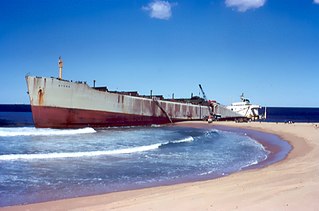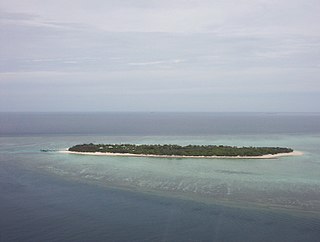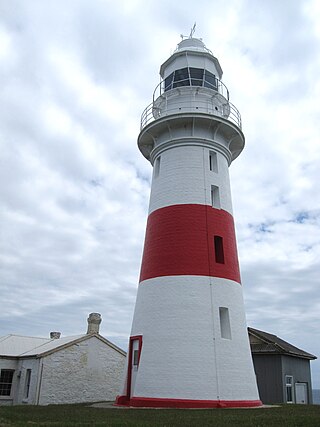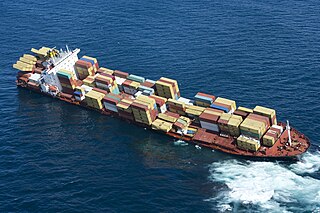
Low Head is a rural residential locality in the local government area (LGA) of George Town in the Launceston LGA region of Tasmania. The locality is about 5 kilometres (3.1 mi) north of the town of George Town. The 2016 census recorded a population of 572 for the state suburb of Low Head. It is a suburb of George Town, on a peninsula at the mouth of the Tamar River.

MVNew Carissa was a freighter that ran aground and broke apart on a beach near Coos Bay, Oregon, United States, during a storm in February 1999. An attempt to tow the bow section of the ship out to sea failed when the tow line broke, and the bow was grounded again. Eventually, the bow was successfully towed out to sea and sunk. The stern section remained on the beach for over nine years until it was dismantled and removed in 2008.

MV Sygna was a Norwegian bulk carrier built by Austin & Pickersgill for J. Ludwig Mowinckels Rederi in 1967. It ran aground on Stockton Beach in Australia during a major storm in 1974. After its bow section was refloated, its stern remained beached and became an icon and landmark for the local area, until the visible remains of the wreck collapsed into the sea in 2016.

Pasha Bulker, later known as MV Drake and now MV Anthea, is a Panamax bulk carrier of 76,741 tonnes deadweight (DWT) operated by the Lauritzen Bulkers shipping company and owned by Japanese Disponent Owners. While waiting in the open ocean outside Newcastle harbour to load coal, Pasha Bulker ran aground during a major storm on 8 June 2007 on Nobbys Beach, New South Wales, Australia. It was refloated and moved to a safe location offshore on 2 July 2007 before being towed to Japan for major repairs on 26 July 2007.

Shenzhen Energy Group Company Limited, formerly Shenzhen Energy Investment Company Limited, is one of the main power generation companies in Shenzhen, Guangdong, China. It involves in developing all types of energies, researching and investing high new energy-related technologies. Huaneng Power International is now the second largest shareholder of Shenzhen Energy.

The islands and reefs of the Capricorn and Bunker Group are situated astride the Tropic of Capricorn at the southern end of the Great Barrier Reef, approximately 80 kilometres east of Gladstone, which is situated on the central coast of the Gladstone Region, Queensland, Australia.
Irving Whale is a Canadian barge that sank off the north coast of Prince Edward Island, while en route from Halifax, Nova Scotia to Bathurst, New Brunswick, with a cargo of Bunker C oil in a rich fishing area. It is "one of Canada's most notorious nautical disasters". The barge, owned by J.D. Irving Ltd., had carried oil for JDI from 1967 until it sank in 1970. She was refloated in 1996, re-fitted as a deck barge, re-activated, and renamed ATL 2701 in 2001 and renamed again in 2009, as Atlantic Sea Lion. Since the accident, she only transports dry cargo.

The 2010 Great Barrier Reef oil spill occurred on 3 April 2010, when the Chinese bulk coal carrier, MV Shen Neng 1 ran aground east of Rockhampton in Central Queensland, Australia. The vessel is owned by Shenzhen Energy Transport Co. Ltd.

Jia Yong, formerly MV Shen Neng 1 was a Chinese bulk carrier built in 1993 as Bestore. She was sold in 2007 and renamed Shen Neng 1. In 2010, she ran aground off Great Keppel Island in Queensland, Australia, spilling oil into Great Barrier Reef waters. She was repaired and returned to service, where she operated until being scrapped in 2017.

Low Head Lighthouse is in Low Head, Tasmania, about 7 kilometres (4.3 mi) north of George Town on the east side of the mouth of the Tamar River. It was the third lighthouse to be constructed in Australia, and it is also Australia's oldest continuously used pilot station. This light is now unmanned and automated.

MV Rena was a 3,351 TEU container ship owned by the Greek shipping company Costamare Inc. through one of its subsidiaries, Daina Shipping Co. The ship was built in 1990 as ZIM America for the Israeli shipping company Zim by Howaldtswerke-Deutsche Werft AG in Kiel, Germany. She was renamed Andaman Sea in 2007 and had sailed under her current name and owner since 2010.

The Rena oil spill occurred off the coast of Tauranga, New Zealand in October 2011. The spill was caused by the grounding of MV Rena on the Astrolabe Reef. The Rena was a container ship and cargo vessel owned by the Greek shipping company Costamare Inc., through one of its subsidiary companies Daina Shipping. The spill has been described as New Zealand's worst maritime environmental disaster.
The SS Wafra oil spill occurred on 27 February 1971, when SS Wafra, an oil tanker, ran aground while under tow near Cape Agulhas, South Africa. Approximately 200,000 barrels of crude oil were leaked into the ocean. The larger part of the ship was refloated, towed out to sea, and then sunk by the South African Air Force to prevent further oil contamination of the coastline.
This is a list of notable events relating to the environment in 2009. They relate to environmental law, conservation, environmentalism and environmental issues.

MV Canadian Miner was a Canadian laker that was part of the fleet of Upper Lakes Shipping from 1994–2011. Initially constructed as Maplecliffe Hall in 1966, the ship was renamed Lemoyne in 1988 before becoming Canadian Miner in 1994. In 2011, the name was shortened to just Miner. In 2011 the vessel was taken out of service and sold for scrapping. While en route to the scrapyard in Turkey, the ship ran aground off Nova Scotia in 2011. The vessel was broken up in 2014 in Nova Scotia.
Sanko Harvest was a 32,502 DWT dry bulk carrier that sank off Esperance, Western Australia after striking a charted reef on 14 February 1991. The Korean-crewed Japanese-owned ship was 174 metres (571 ft) long and was carrying a cargo of 32,790 tonnes of phosphate fertilizer valued at A$8.9 million. Also on board were 677 tonnes of heavy bunker fuel and 40 tonnes of light diesel oil.
The MV Treasure oil spill occurred on 23 June 2000, when the ship sank six miles off the coast of South Africa while transporting iron ore from China to Brazil. The ship was carrying an estimated 1,300 tons of fuel oil, some of which spilled into the ocean, threatening the African penguin populations living on nearby islands. Cleanup efforts began promptly after the incident with particular attention being paid to salvaging the penguin communities.

The MV Wakashio oil spill occurred after the Japanese-controlled bulk carrier Wakashio ran aground on a coral reef on 25 July 2020 at around 16:00 UTC. The ship began to leak fuel oil in the following weeks, and broke apart in mid August. Although much of the oil on board Wakashio was pumped out before she broke in half, an estimated 1,000 tonnes of oil spilled into the ocean in what was called by some scientists the worst environmental disaster ever in Mauritius. Two weeks after the incident, the Mauritian government declared the incident a national emergency.
MV Zhe Hai 168 is a Chinese Supramax bulk carrier operated by Zhejiang Shipping Group that ran aground in the Philippines in April 2016 and April 2023. It has an overall length of 190 m (620 ft), a width of 32.3 m (106 ft), and a draft of 11.3 m (37 ft). It has a gross tonnage of 33,147 GT and a carrying capacity of 57,033 DWT.











